‘Deeply I loved thee, 31 West Hill!’ It was only recently, exploring my new neighbourhood in north London, that I put a facade to these words from John Betjeman’s verse autobiography, Summoned by Bells: about halfway up one of London’s steepest streets, which runs north from Parliament Hill to Highgate village, a blue plaque on an elegant, semi-detached villa announces it as the poet’s home from 1908–17. The house, with Hampstead Heath behind it, is at the centre of the first three chapters of what Betjeman referred to (only semi-mockingly) as ‘the epic’, which charts the poet’s small triumphs and tragedies up to the age of 22.
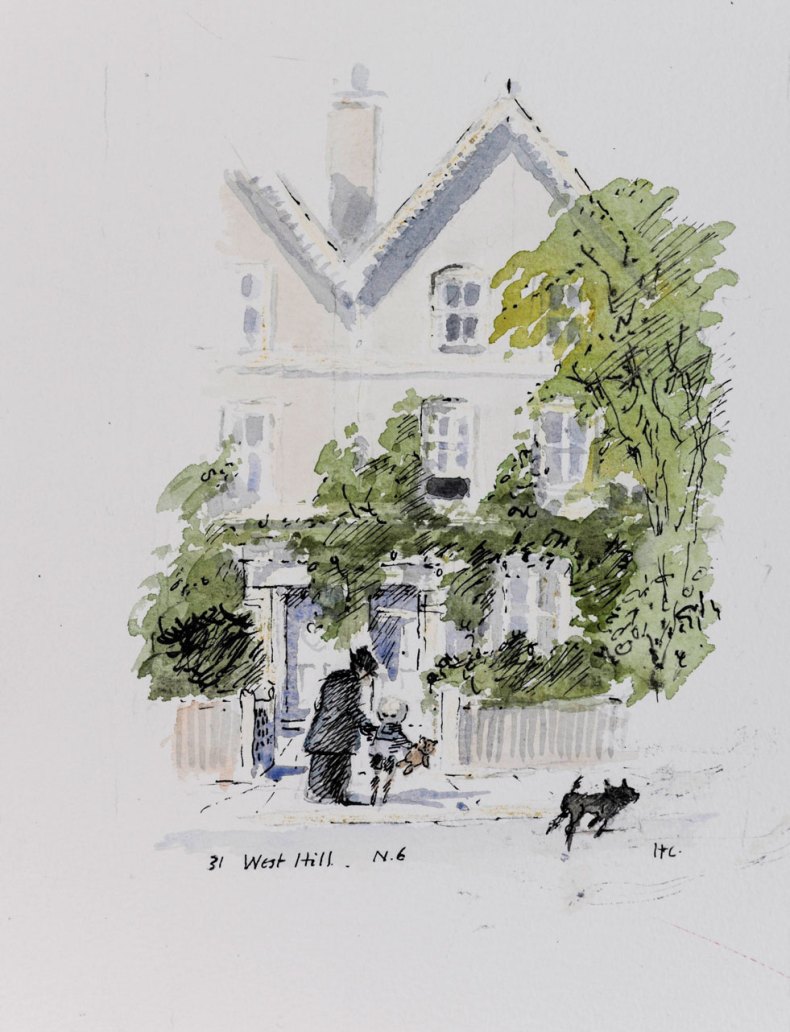
‘31 West Hill. N6’ by Hugh Casson for The Illustrated Summoned by Bells (1989)
Summoned by Bells was first published 60 years ago. Amid all the white noise of 2020, such an anniversary was never going to sound anything more than a faint tinkle. Indeed it’s hard to marry Betjeman’s world of buttered toast, maids and bridge evenings with one of face masks, isolation and hand-sanitiser (just as the First World War appeared only at the periphery of the schoolboy’s vision, in sepia prints of Haig and other British generals ‘given / Gratis with each half-pound of Brooke Bond’s tea’). Yet exactly that which for Betjeman represented a refuge from childish anxieties has over the last nine months served a similar function for many Londoners seeking solace in open green space: ‘in the west / Were health and sunshine, bumps on Hampstead Heath’.
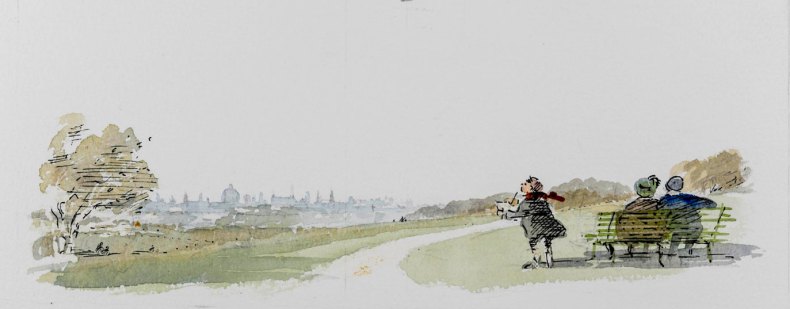
Illustration of Hampstead Heath by Hugh Casson for The Illustrated Summoned by Bells (1989)
Certainly, the book resonated with contemporary readers. It sold out immediately, notwithstanding plenty of spiky reviews. ‘Summoned by Bells is an enormous middle-class success,’ went one, ‘because it offers a great number of people a kind of lucky-dip from which they can extract little parcels of the familiar past tied up in neat and easily recognizable metres.’ Perhaps inspiration for this reviewer’s metaphor came from the jacket of the first edition. Bevis Hillier’s biography of Betjeman provides fascinating – and often comical – insight into how involved the poet was with the appearance of the finished book. ‘[T]he right kind of dust wrapper,’ the poet wrote to his publisher Jock Murray, ‘is BROWN PAPER of the light, rather straw-coloured variety printed on with black ink and, if need be, red to diversify the black. This will go superbly well with the olive green of the binding and is the same colour right through and the right sort of wrapping paper for style of the book.’ Betjeman took advantage of Murray’s absence on holiday, it seems, to harangue the publisher’s assistant further about the dust jacket: ‘Is there something in the type specimen book which is a bit more vertical? Something Art Nouveau-ey […] and not suggesting too much Faber & Gwyer or one of the university presses, but looking like early EVERYMAN editions with a strong hint of J.M.DENT & SONS and Letchworth Garden Suburb.’
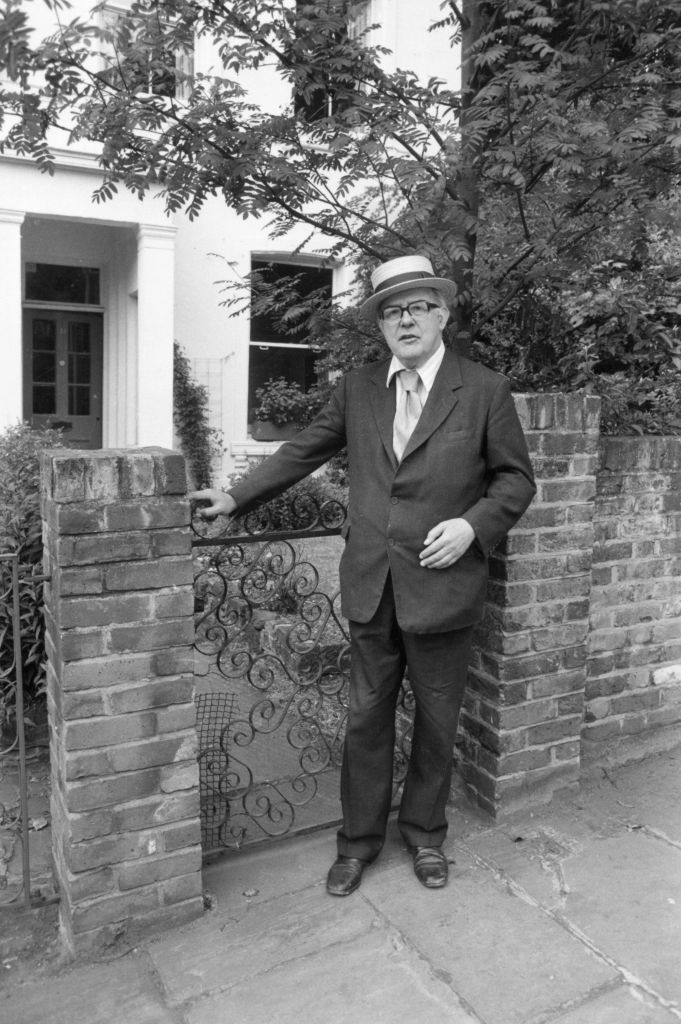
John Betjeman (1906–84) at the gate of 31 West Hill, Highgate, in June 1974. Evening Standard/Getty Images/Hulton Archive
Betjeman was as particular about the book’s endpapers, sending Murray a wood engraving of a bell from Whitechapel Bell Foundry to be used as a model design, and following up later with illustrated suggestions: ‘As you know, English bells are rung right round and so on till they are up again. If you are to cut out your bells and paste them like this, the endpapers would give a wonderful effect of ringing bells but perhaps this is asking too much. They should read from left to right starting down, going by quarters round till they are up and down again the same way.’ For the long-suffering publishing staff it was almost too much – one of them interrupted the chief’s holiday with an exasperated note: ‘Summoned again by Betjeman. I am sorry!’ But the author got his way, and now the cheerful Whitechapel bells on the endpapers seem particularly appropriate for the conservationist in Betjeman, who would surely be saddened to know that at present the fate of that historic bell foundry hangs in the balance.
To illustrate the book, the publishers had originally intended to call on Osbert Lancaster, a John Murray regular and friend of Betjeman’s since Oxford, and John Piper, who had done the Shell Guides with the poet in the previous decades. Betjeman, however, insisted on using the relatively untried hand of Michael Tree – probably at least in part to please Elizabeth Cavendish, his mistress and Tree’s sister-in-law. Hillier calls his sketches, reproduced at each chapter heading, ‘scratchy, amateurish, 1910-guidebook style’ – but they have a simple charm somehow of a piece with this parcelled-up, primer-like first edition. (Deliciously fitting, too, is the fact that the the run of a limited edition was ruined by an upset tea trolley at the printers.)
Five years after Betjeman’s death in 1984, his verse autobiography was given a fuller visual interpretation by Hugh Casson. The architect and former Royal Academy president was in so many ways the ideal candidate for the job: Hampstead-born, he had many times campaigned with Betjeman against the demolition of Victorian buildings. But most valuable were his observational skills as a draughtsman – hints of the gothic on a church spire, a passing dog momentarily distracted by a coster’s cart – and his obvious empathy with the small boy Betjeman: dwarfed, with his teddy bear Archibald, by the facade of no. 31 West Hill, or by drawing-room bridge evenings ‘for friends / From terra-cotta flats on Muswell Hill’. Casson conveys the thick, Edwardian fastness of such evenings with heavy pelmeted drapes and equally festooned ‘ladies vaguely designated “aunts”’.
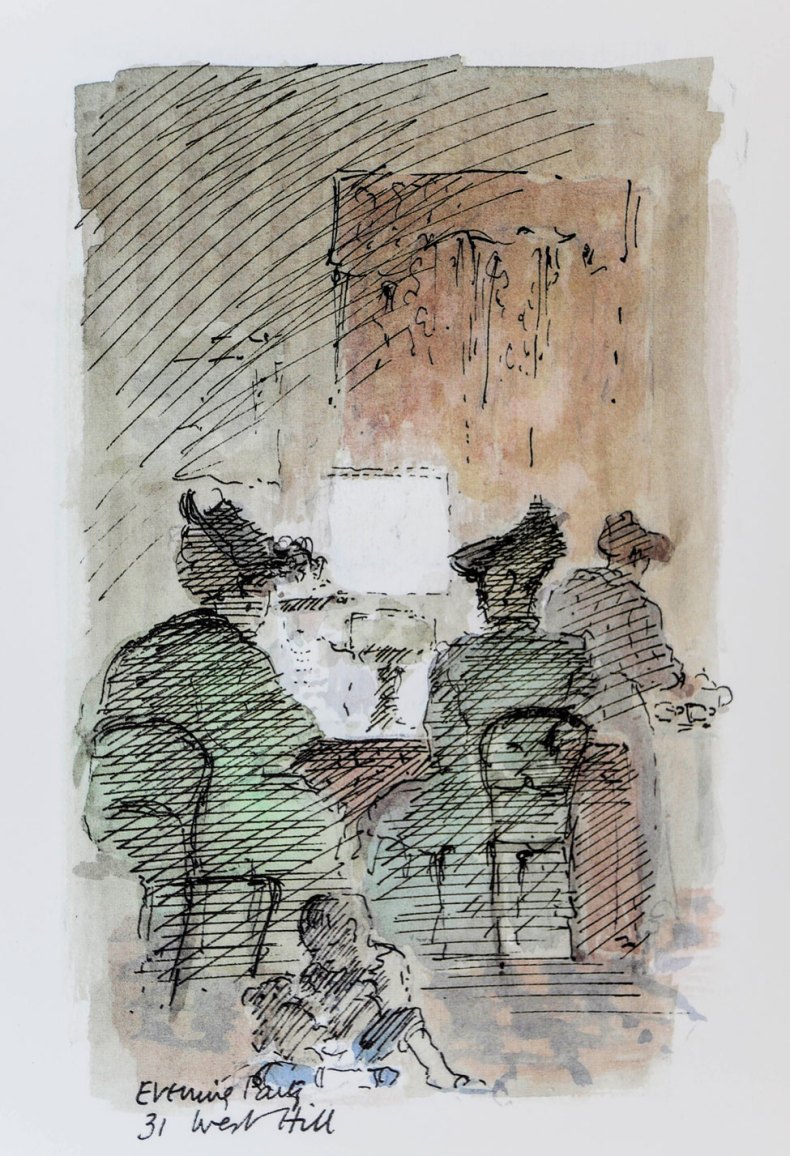
‘Evening Party 31 West Hill’ by Hugh Casson for The Illustrated Summoned by Bells (1989)
In Chapter II, ‘The Dawn of Guilt’, Casson captures so touchingly the aspiring young poet on Hampstead Heath, pencil poised and standing ‘tip-toe upon a little hill, / Awaiting inspiration from the sky’ – that eager, upturned little face all too soon clouded, we can well imagine, by acquaintance with ‘The gap from feeling to accomplishment’. Later, the artist lends a distinctly digit-like appearance to the funerary monument that stands as a rebuke to Betjeman for shunning the family business in favour of poetry: ‘that red granite obelisk that marks / The family grave in Highgate Cemetery / Points an accusing finger to the sky’.
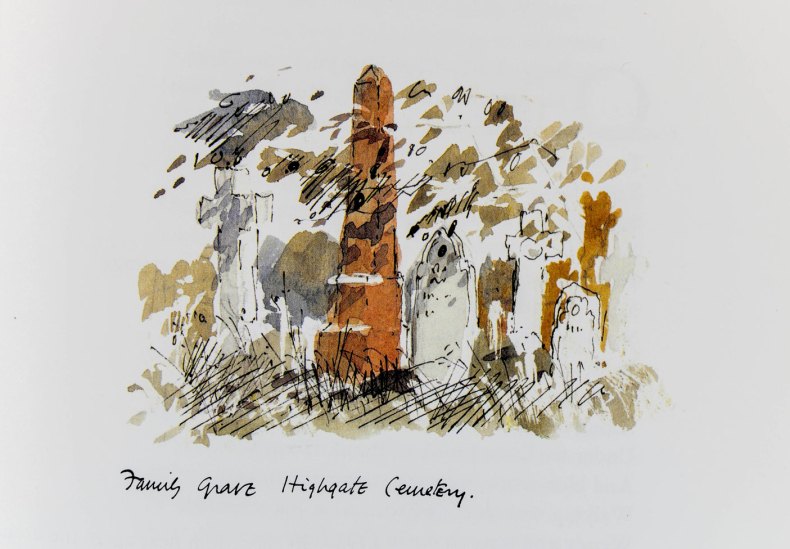
‘Family Grave Highgate Cemetery‘ by Hugh Casson for The Illustrated Summoned by Bells (1989)
Casson’s obvious delight in period detail – the advertising type on the gable ends of red-brick mansion blocks or omnibuses, the horse trams in the street – picks up the poet’s own nostalgia for the time, writing about it several decades (and two world wars) later. Near the beginning of Summoned by Bells, Betjeman writes of his suburban surroundings: ‘Then Millfield Lane looked like a Constable / And all the grassy hillocks spoke of Keats.’ On reading these lines in a typescript, one of his editors commented: ‘Not to you, who had not heard of them then. Omit.’ Betjeman left the lines in, insisting: ‘But there is a lot I wouldn’t have noticed at that time…’
What the young Betjeman did notice, and what seems to have been a formative influence on the poet he was to become, was his family’s exact place in that world. In 1975, interviewed by Roy Plomley for Desert Island Discs, he explained that he enjoyed Britain more than any other country because ‘I know what sort of people live in what sort of houses’. In Summoned by Bells, the boy Betjeman can sit in his eyrie at 31 West Hill, ‘Glad that I did not live in Gospel Oak’. Yet that buttered-toast soundness is spoiled when, in the poem ‘False Security’, the boy goes further up the hill to a smart party at The Grove, and overhears his hostess calling him ‘that strange, rather common little boy’. As Frank Kermode wrote in the LRB in 1988, the episode would firmly confirm his opinion ‘that by birth his place was, sadly, only about half-way up the hill’.
Unlimited access from just $16 every 3 months
Subscribe to get unlimited and exclusive access to the top art stories, interviews and exhibition reviews.

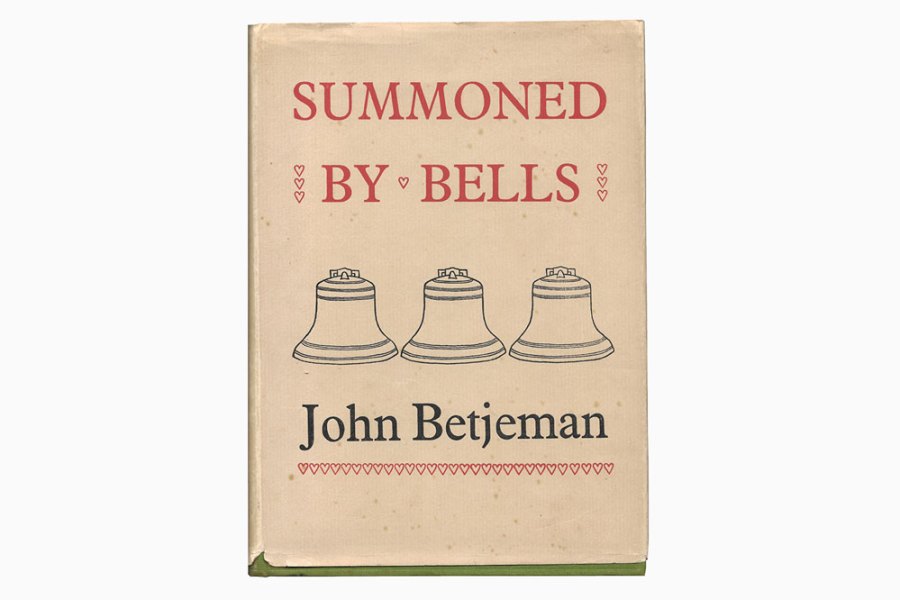
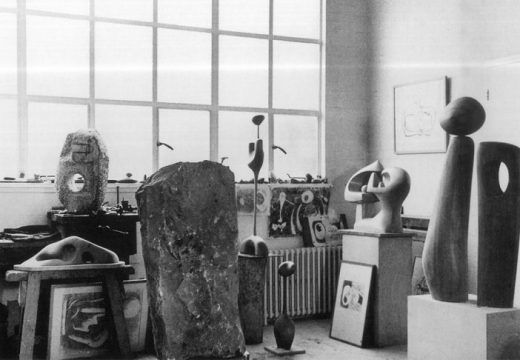
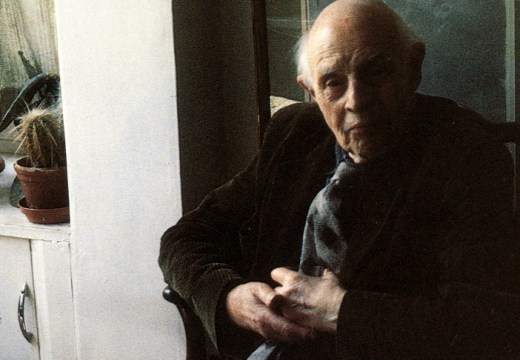
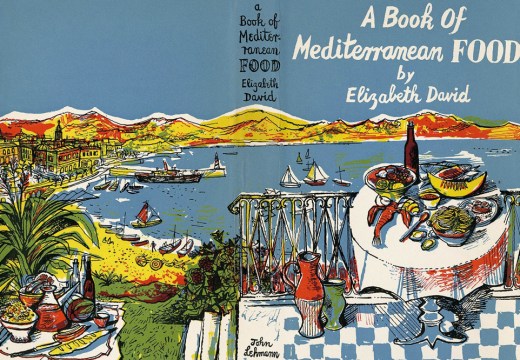









![Masterpiece [Re]discovery 2022. Photo: Ben Fisher Photography, courtesy of Masterpiece London](http://www.apollo-magazine.com/wp-content/uploads/2022/07/MPL2022_4263.jpg)
Why are fathers so absent from art history?